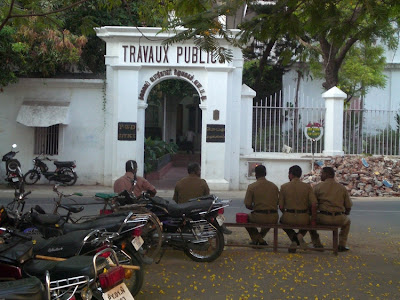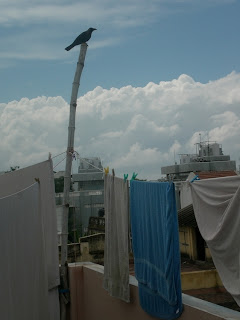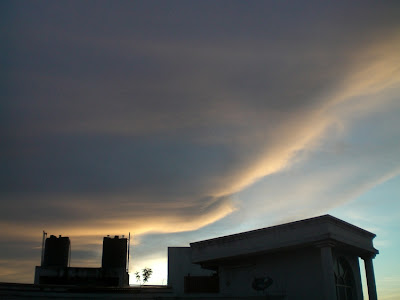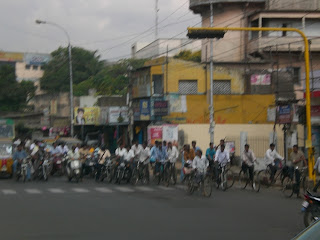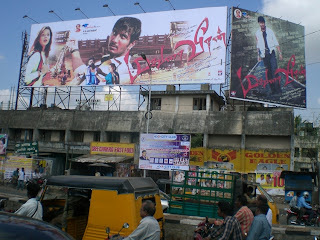Auroville is an autonomous community outside of Pondicherry that was settled in the late sixties by a group of French hippies and followers of the Indian mystic yogi Sri Aurobindo. The community coalesced under the guidance of "The Mother", a Frenchwoman who supposedly was endowed with the spiritual powers of Sri Aurobindo at his death. The community was conceived by the Mother as an area free of nationalism, religious dogma and greed where people from all over the world could co-exist and work towards a true "human spiritual evolution". The area of the Auroville village itself was designed by the French architect Robert Anger to resemble the shape of a galaxy and house over 50 thousand people. To date, only about 20 percent of his plan has been built and something less than 10 thousand people live in Auroville.
G and I were excited to come and see Auroville as soon as we arrived in the area, but the unbelievable heat we encountered when we arrived in Pondicherry kept us in the "French Quarter" of "White Town" for days, sipping lime sodas and white wine in courtyard of the French restaurant across the street from our guest house (the restaurant is called Satsanga, but we called it "Le Club" in a bout of "Lost Generation" romanticism).
From various storefronts and boutiques operated by Auroville in Pondicherry we got an idea of the beliefs of Sri Aurobindo and the Mother, which were a kind of synthesis of Eastern religious thought, transcendental Meditation and "modern" science (most of their writing together was done in the 1950s). There was something about using meditation to make your body's cells become "aware" and to "evolve" yourself into a new kind of being in your lifetime. Some of this smacked of Scientology or new-agey cultish ideas.
The owner of our guesthouse on Rue Labourdanais was an older Frenchman who had come to settle in Pondicherry after 20 years of hitchhiking back and forth between there and Paris, where he had worked as a bellhop at a famous, iconic hotel. One afternoon he sat with us on the roof and had wine and cheese. We asked him about Auroville. "Oh, we do not go there. It is not such nice place. This is... how you say, 'sect'", meaning cult. "They are watching you if you are living there, and if you say the wrong thing, you are out of there. It is not such nice place."
The "heart of Auroville" is the Matrimandir, an enourmous meditation chamber built as an internally symmetrical sphere and painted gold, which is supposed to be a color which draws on the "supra-mental" forces in the universe. Here are some photos:


Although when we arrived the Matrimandir was closed to visitors for construction and there is no photography allowed inside of it, we gleaned from drawings and descriptions that the interior is subdivided into 8 small meditation chambers and one large central one. The large, central chamber is stark white and without music, incense, flowers or religious symbols. There is only an enormous crystal ball in the center of the chamber which is illuminated by a beam of light from a portal in the roof. A computerized tracking light makes sure that the beam is striking the crystal directly at every hour of sunlight.
While we were sitting at the cafeteria in the center of Auroville, we eavesdropped on a conversation that an American initiate was having with an Indian journalist. He described to him how, using the Matrimandir, a believer could quickly enter a deep state of meditation and communication with "the vast", which was apparantly a synonym for "the supra-mental". According to the American (who, we noted with delight, really did have a graying ponytail and a receding hairline), the very shape and structure of the Matrimandir, which came the Mother in a vision and was realized by Robert Anger, was a conductor for this process. Additionally, some kind of spiritual energy which would facilitate this communication was embued into the Matrimandir by the Mother at the moment of her death.
Later we were sitting near the Matrimandir, at the observation area that they had set up for tourists while construction was under way. We saw this older man in a bizarre hilarious yellow outfit with a brimless hat and a red plastic bucket.

I'm not sure our covert giggling and attention drew him, but he walked right up and started talking to us. He was a citizen of Auroville, born in Switzerland but he seemed to identify more as "someone with a connection to this-" and gestured toward the Matrimandir. He told us the range of people how lived in Auroville was enormous, as was the variety of how they built their lives there. Some were more involved with the social and practical concerns of living in a communal society based on cooperation instead of greed, while many other citizens like himself were simply ethereal souls who only lived there to be near the Matrimandir and the "spiritual work" being done. He described this work as something analogous to globalization in world finance- a new phenomena that would soon envelop the whole globe and make us all aware of our connections and interdependence. He stressed that the beliefs of Sri Aurobindo were the only "new" religious and spiritual movement of the modern age, setting them apart from the teachings of other gurus and sects. He told us that the philosophies of Auroville and the metaphysical beliefs they were based on were the most sound of any religious beliefs because they were revealed not just to one man, like the Buddha, Jesus or Muhammad, but to a man and a woman, Sri Aurobindo and the Mother, working together as equals and of one mind. Talking to him was the first time that day G and I felt at all uncynical, becuase we had been walking around Auroville an sneering the whole time at the "naive" and "uninsprired" credos of that were posted all over the visitor's center. We had felt like the ideology of Auroville was still that of Westerners enthralled with "exotic" India, like the Beatles had just arrived there and discovered meditation. But talking with this old man in his goofy yellow outfit, we began to respect a bit more the project these people were undertaking on the coast of southeastern India.
Of course, we had plenty more qualms with what we saw in Auroville. Genevieve was appalled by the mangy, starving conditions we saw many dogs in as we scootered around. Doesn't a "model" community have an obligation to take care of it's canine citizens as a matter of course? I was also struck that on the introductory video you watch in the Visitor's center, you see a serene, idyllic, multicultural community, while driving through it's more of your average ragged, shambling Indian village with many more foreigners. The social problems of India are just as apparent there- the aforementioned dog issue, as well as the usual array of strewn-about garbage. The introductory video shows fencing and reiki and baking and solar panels and looks like it could have been shot at Oberlin college. As a visitor, what you see is a lot more chaotic an unpretty, but they do make it clear that Auroville is not a tourist attraction, so you can't really get a sense of what is going on behind the scenes (the paranoid side of my mind says "Thank God!").
I was glad that we got even a glimpse of a community like Auroville, though I must admit, I got an even greater sense of well-being later that night back at "Le Club", tucking into a filet and glass of wine.








